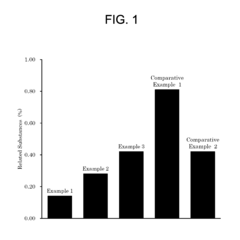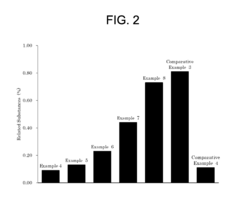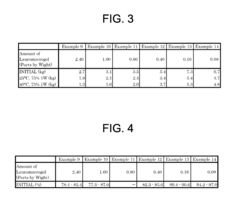Research on improving the stability of cyclopentasiloxane - Eureka
Cyclopentasiloxane Stability Challenges and Goals
Cyclopentasiloxane, a cyclic siloxane compound, is widely utilized in various applications, including personal care products, coatings, and lubricants. However, its stability under certain conditions, such as high temperatures or exposure to specific chemicals, can be a limiting factor. Addressing this challenge is crucial for expanding its applications and ensuring consistent performance across different environments.
Market Demand for Stable Cyclopentasiloxane
- Growing Demand for Stable Cyclopentasiloxane Cyclopentasiloxane is widely used in personal care products, coatings, and lubricants due to its low surface tension and high thermal stability. As consumer demand for high-performance and environmentally friendly products increases, the market for stable cyclopentasiloxane is expected to grow steadily.
- Emerging Applications
Stable cyclopentasiloxane finds new applications in areas such as:
- Biomedical devices and implants, leveraging its biocompatibility and low toxicity
- Advanced electronics, as an insulating and protective material for semiconductors
- Renewable energy technologies, as a heat transfer fluid or lubricant
- Regulatory Drivers Stricter environmental regulations and consumer preferences for sustainable products drive the demand for stable cyclopentasiloxane, as it is a more environmentally friendly alternative to traditional silicone-based materials.
- Market Segmentation
The market for stable cyclopentasiloxane can be segmented based on:
- End-use industries (personal care, coatings, lubricants, electronics, etc.)
- Geographic regions (North America, Europe, Asia-Pacific, etc.)
- Product type (pure cyclopentasiloxane, modified/functionalized variants)
Current State and Limitations of Cyclopentasiloxane Stability
- Stability Issues
Cyclopentasiloxane, a widely used silicone compound, faces stability challenges that limit its applications. Factors like heat, moisture, and impurities can trigger polymerization, leading to viscosity changes and gel formation. - Degradation Mechanisms
Hydrolysis and oxidation are the primary degradation pathways, causing ring-opening and cross-linking reactions. Understanding these mechanisms is crucial for developing stabilization strategies. - Impurity Effects
Trace amounts of acids, bases, and metal ions can catalyze degradation reactions, accelerating instability. Identifying and controlling impurities is essential for improving shelf life. - Storage Conditions
Exposure to heat, light, and air can initiate or accelerate degradation processes. Proper storage conditions, such as cool, dark, and inert environments, are necessary to maintain stability. - Stabilizer Limitations
Current stabilizers, like antioxidants and acid scavengers, offer limited protection and may have compatibility issues or introduce new impurities, necessitating the development of more effective and compatible stabilization systems.
Evolution of Cyclopentasiloxane Stabilization Techniques

Existing Solutions for Cyclopentasiloxane Stability
01 Cyclopentasiloxane substitutes and alternatives
Compounds and compositions developed as substitutes or alternatives to cyclopentasiloxane, aiming to replace or reduce its use, offering improved properties or addressing concerns.- Cyclopentasiloxane substitutes and alternatives: Compounds and compositions developed as substitutes or alternatives to cyclopentasiloxane, aiming to replace or reduce its use, offering improved properties or addressing potential concerns.
- Cyclopentasiloxane in formulations and applications: Incorporation of cyclopentasiloxane into various formulations and applications, such as cosmetics, coatings, and biocidal compositions, leveraging its properties or combining it with other components.
- Stability evaluation and measurement techniques: Methods and techniques developed to evaluate and measure the stability of materials, including cyclopentasiloxane-based compositions, assessing thermal, oxidative, or other forms of stability under different conditions.
- Stability enhancement and improvement strategies: Approaches explored to enhance the stability of materials, including those containing cyclopentasiloxane, involving the use of additives, specific formulations, or processing techniques.
- Stability assessment and monitoring methods: Methods and systems developed to assess and monitor the stability of materials, processes, or systems, involving the calculation of stability indexes, monitoring of parameters, or evaluation of specific characteristics related to stability.
02 Cyclopentasiloxane in formulations and applications
Utilization of cyclopentasiloxane in various formulations and applications, such as cosmetics, coatings, and biocidal compositions, leveraging its properties or combining it with other components.03 Stability evaluation and measurement methods
Methods and techniques developed to evaluate and measure the stability of materials, systems, or processes, assessing thermal, oxidative, or other forms of stability under different conditions or over time.04 Stability enhancement and improvement strategies
Strategies and approaches explored to enhance or improve the stability of various materials, compositions, or systems, involving the use of additives, specific formulations, or processing techniques.05 Stability assessment and monitoring in applications
Methods and systems developed to assess and monitor the stability of various applications, processes, or systems, evaluating factors such as structural, electro-mechanical, or software stability.
Key Players in Cyclopentasiloxane Production
China Petroleum & Chemical Corp.
Versum Materials US LLC
Core Innovations in Cyclopentasiloxane Stabilization
- The use of lauromacrogol as an additive, which is incorporated into the candesartan cilexetil-containing preparation in a specific ratio. the lauromacrogol additive is found to be effective in stabilizing candesartan cilexetil and inhibiting the generation of related substances.









